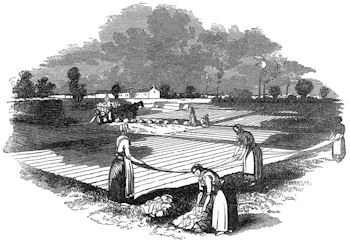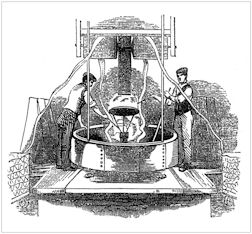Industry in the Vale of Leven - Page 1
Note: Within the Vale of Leven industry category we are including agriculture in the Vale of Leven. The traditional industry content consists of five pages with agriculture having a page of its own.
Industry Page 2 | Industry Page 3 | Industry Page 4 | Industry Page 5
INTRODUCTION
At the time of writing, in spring 2009, the number of people working in the manufacturing industry in the Vale of Leven was no more than 500. This is approximately the same number of people as were employed in manufacturing in the Vale in the 1780's, immediately prior to the explosive growth of the textile industry in the Valley. There is a very obvious difference, of course, and that is that the population of the Vale was then about 2,500 - and had been about 600 only 30-40 years previously - while just now it is about 25,000. That population grew on the back of the industrial and economic success of Vale textile enterprises during the 19th century.
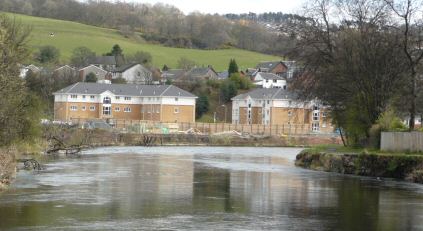
New houses on the site of the old Dalmonach works
The majority of people who now live in the Vale are descendants of people who came in the19th and early 20th centuries to work in the textile industry. They must wonder, what happened? They must also wonder of course how that population is sustained on such a declining industrial base, and how it can be that the fewer the jobs there are in the Vale, the more houses there are being built. Since so many of these new houses are being built on the former sites of factories, a further question is, where would any new industrial enterprises be built? And that leads to the question “will industry ever come back anyway?” We can at least try to answer the question “what happened?” and hopefully be encouraged to start thinking about industrial regeneration.
The Vale has been in similar, although not the same, positions before. Although the 19th century and the Victorian age in particular was a time of great growth and success for the textile industry in the Vale, by the early years of the 20th century, these enterprises were in terminal decline. For a spell in 1906-14, it seemed that motorcar manufacturing by Argyll motors might offset that decline. This, just, proved to be a false dawn, but facing up to the full consequences of that was postponed by the First World war.
However, at the war's end, the Vale was in economic depression by the early 1920's, many years before the international Depression of the 1930's turned what was a crisis into a disaster for the majority of Vale families. The marginal flashes of light that there were in the gloom - the British Silk Dyeing and Royal Naval Torpedo Factory, were always going to be overwhelmed by the darkness.
In 1945 government strategy was to assist job creation. The biggest single difference in industrial activity in the Vale in the whole 20th century was the opening of Strathleven Industrial Estate in 1949. New light engineering employers arrived - from England and America - and brought about 4,000 new jobs at the peak overlap of their operations in 1970. However, it has been mainly downhill from the early 1970's, interrupted by brief periods of plateauing, until we've reached the point, in mid 2006, where we will any day be back down at levels of industrial employment last seen in the Vale in the 1700's. We're witnessing the clock being put back 200 years, to just about where the story of modern industry in the Vale begins.
OVERVIEW OF THE INDUSTRIAL HISTORY OF THE VALE
The plentiful supply of clean water from the River Leven brought the first industrial operations to the Vale. This was the bleaching of finished textiles, usually linen to begin with, by dipping them in water and laying the cloth out in the open air to be bleached dry in the Scottish summer. This was a very low-tech operation, with the only quasi-chemical element being the application of sour milk to help the bleaching process. Indeed it was truly a cottage industry to begin with, because the cottage-based linen weavers bleached whatever they'd just woven at the front doors of their cottages.
In 1715, a larger-scale bleaching operation was started in the fields at Dalquhurn, using water from the River Leven. By 1727-28 more serious operations were undertaken at Dalquhurn. The Dalquhurn Bleaching Company was established by Walter Stirling & Archibald Duncan, with government financial assistance of £600, on Dalquhurn Point, where water could easily be drawn off from the Leven. A number of lades led water into open fields surrounded by beech hedges - which prevented the cloth being blown away by the wind.
Workmen were brought over from Holland, which was the world leader in bleaching at the time, to advise in the process. The cloth was laid out by hand and the operation was essentially still a simple one, with only the size of the bleach fields, the lades, and the beech hedges distinguishing it from the existing cottage industry. No large factory buildings were required, nor were many people employed, but it established the Vale as a suitable place for the Bleaching industry. The cloth was not manufactured in the Vale - there were over 250 linen mills alone in other parts of Scotland - and it was mainly brought in by boats on the Leven.
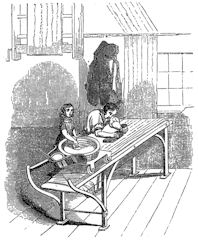 It took another 40 years for any other textile manufacturer to arrive in the Vale, and when they did, they brought another skill, block printing, to the area. John Todd & Co opened a printworks, Levenfield Printworks in 1768, on a site, which later became part of Alexandria Works, or the Craft. It was located at the northern end of these works. The printing process at this time was basic. An engraver cut out a pattern on a wooden block, the printer dipped it in whatever dyes were available, and then pressed the block onto the piece of cloth. Printing completed. (See poem on right.)
It took another 40 years for any other textile manufacturer to arrive in the Vale, and when they did, they brought another skill, block printing, to the area. John Todd & Co opened a printworks, Levenfield Printworks in 1768, on a site, which later became part of Alexandria Works, or the Craft. It was located at the northern end of these works. The printing process at this time was basic. An engraver cut out a pattern on a wooden block, the printer dipped it in whatever dyes were available, and then pressed the block onto the piece of cloth. Printing completed. (See poem on right.)
(Click Image to Enlarge)
The Leven Printfield, as it was sometimes called, was therefore the first print works in the Vale. The works were not used for many years, but the Todds sold them in 1850 to the operators of the adjoining Croftingea Works. When Croftingea itself changed hands again in 1860, the two works were combined as Alexandria Works.
At about the time that Todd & Co was lining up its move into Levenfield, an altogether more serious player was reviewing his options from the increasing discomfort of his works at Dalsholm on the banks of the Kelvin in Maryhill, Glasgow. William Stirling was a member of a Glasgow “Tobacco Lords” family. These families had made incredible sums of money (for the day), from importing tobacco from America. The Stirling Building in Royal Exchange Square, Glasgow, once the Stirling Library, now Glasgow's Gallery of Modern Art (GOMA), was the town house of the Stirling family.
William was one of the leading businessmen in Scotland at the time, with plenty of money to invest. He had become involved in textiles many years before, which was a lucky move considering that the American War of Independence, which destroyed Glasgow's tobacco business, broke out when Stirling's career was at its peak. He had opened a factory, which printed small pieces of cloth such as handkerchiefs at Dalsholm in 1750, and it was doing rather well. However, two things were worrying him: first, the quality of the water in the Kelvin was no longer pure enough for the textile industry; second, labour was not in plentiful supply.
Stirling looked about the west of Scotland for a suitable site. The fast-flowing Leven seemed to answer his first problem, while in 1770 the competition for labour was Dalquhurn or Levenfield, both of which employed only a handful of people. Also, the Walter Stirling of Dalquhurn Bleaching Company was his uncle, so he knew all about the Vale.
Land at Cordale was already being used for bleaching, when William Stirling came calling in 1770. He bought Cordale from John Campbell of Stonefield's Levenside estate (later Strathleven) in 1770. He then built not only Cordale Printworks on the site, but also a fine house for himself, Cordale House, on land near to the Printworks, but not within its grounds. He named his new company William Stirling and Sons, the name it retained until it was absorbed into the United Turkey Red Ltd (UTR) in 1897. Thus by 1770, one of Scotland's leading businessmen had chosen the Vale as the site of his new out-of-town factory just half a mile or so from another factory owned by another Stirling.
By this time, Mrs Jane Telfer Smollett, had called the area, which included Dalquhurn and Cordale, the village of Renton, in 1762, in honour of her daughter-in-law, Cecilia Renton. Between them, and this was before William Stirling arrived on the scene, what were still the two bleach fields of Dalquhurn and Cordale, were employing about 350 people at their summer peak, and Mrs Smollett thought it time to bring a bit of formality to social arrangements.
Although William Stirling died in 1777, his sons carried on the business with considerable success. They bought Dalquhurn in 1791, and from them on Cordale and Dalquhurn were run as united factories. To begin with, Cordale did the printing and finishing, while Dalquhurn did the bleaching. By 1828 Dalquhurn was also doing Turkey red dyeing.
Cordale prospered throughout the 19th Century when it employed about 700 people at its peak, and was rebuilt and extended. The railway branch line into Dalquhurn was extended along the towpath into Cordale in the 1885, and it was still prospering when the UTR was formed in 1897. The 20th century was not so kind. All the works suffered from a lack of orders from time to time. Cordale was closed shortly after 1945, by which time the whole of the UTR was struggling because of a lack of enough business to keep all of its factories open.
All the printing operations were transferred to Alexandria Works. Unlike all of the other UTR factories, parts of which at least were put to other uses when they closed, Cordale was demolished almost immediately after closure. Parts of the boundary wall, and a few small buildings have survived. In the 1930's, the Council had started to build the Cordale housing estate on the adjoining Cordale House grounds, and indeed Cordale House was demolished in the 1930's to make way for the estate. Subsequent housing developments have encroached on parts of the Cordale Works site, but much of it remains unused.
After Dalquhurn was bought in 1791, it initially continued its primary role as a bleachfield. The actual bleaching was very much a summertime job because of the Scottish weather. In 1841 a new process arrived in the Vale, which allowed all of the bleach fields to do the bleaching indoors. This, plus Turkey red dyeing and new processes, meant that Dalquhurn was frequently rebuilt and extended. The couple of small, buildings on the edge of the background of the 1775 print of Tobias Smolletts monument, gradually give way to the major and imposing industrial buildings of the Victorian Dalquhurn which we can still just about picture to-day.
At the peak of its output, Dalquhurn was employing about 1,000 people on a regular basis. Like Cordale, it did well throughout the 19th century - apart from a series of fires in 1876. It was assumed that they were started deliberately, and a reward of £100 was offered in the hope of catching the culprit. It may well have been wilful fire-raising, but other works suffered from fires - Dalmonach was almost completely burned down by one in 1812. Many of the raw materials used in the works were combustible, and fire prevention tended to be learning the lesson after the event.
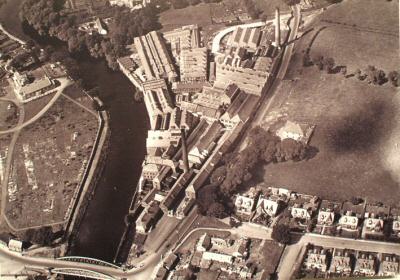
Dalmonach works with the old Bonhill Bridge at the bottom of the picture.
A branch railway line was built to the works in 1885. It left the main line at the Howgate just south of Renton station and ran along the southwestern boundary of the works. It then went along the towpath to Cordale. This seems quite late in the day to build a line. The railway had arrived in Renton 30 years previously, after all, and Dalquhurn and Cordale were the last of the Vale factories to have their own sidings. The UTR strike of 1931 (see the UTR entry below) had Dalquhurn as its flash point. Two days after the strike began a crowd of 5,000 descended on Dalquhurn, fought with police, stoned the blacklegs' bus, and maintained a picket that ensured that no-one entered any of the UTR works for several weeks.
Page 2 | Page 3 | Page 4 | Page 5

